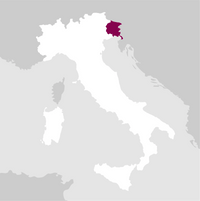Description
This Sauvignon variety is an aromatic grape that has long been cultivated with considerable success in the Colli Orientali del Friuli area, where it best expresses its intense aromatic charge by virtue of the particular microclimate of these areas. The typical "ponca", the soil of which these hills are composed, infuses a pleasant mineral note that gives a pleasant tastiness to the wine.
Awards
Details

Perfume

Color

Taste
Serve at:
10 - 12 °C.
Longevity:
03 - 05 years

Pairings
- Start up year: 1972
- Oenologist: Enrico Raddi
- Bottles produced: 240.000
- Hectares: 74
In the Colli Orientali del Friuli, and especially in Torre Rosazza, the growing of grapevines has a very ancient history. Already known in Roman times, grapes were also grown in the Middle Ages, along with other crops such as olives and grains. In those years, wine was a commodity or a bargaining chip that demonstrated a family’s wealth.
Noble elegance. The history of Torre Rosazza has been tied to the Antonini family, part of the Udine nobility, since the 1600s. Already the lords of the agricultural estate, the Antonini restored the medieval tower and built the villa that became their home in the hills: Turris Rosacea.
After the Antonini, Torre Rosazza passed to the De Marchi family. But more than any other event, the biggest mark on its history was left by the two World Wars. After the Battle of Caporetto, the estate came under Austrian control before returning to Italy at the end of the war. During the World War II it was the scene of fighting between the German occupation army and the Italian Resistance. Read more


| Name | Torre Rosazza Friuli Colli Orientali Sauvignon 2023 |
|---|---|
| Type | White still |
| Denomination | Colli Orientali del Friuli DOC |
| Vintage | 2023 |
| Size | 0,75 l |
| Alcohol content | 12.5% by volume |
| Grape varieties | 100% Sauvignon |
| Country | Italy |
| Region | Friuli-Venezia Giulia |
| Vendor | Torre Rosazza |
| Origin | Oleis di Manzano (Udine) |
| Climate | Altitude: 160 70 m. a.s.l. |
| Soil composition | Marly and eocenic. |
| Cultivation system | Guyot. |
| Plants per hectare | 4,550 |
| Yield per hectare | 6,500 kg/hectare. |
| Harvest | By hand. |
| Wine making | The grapes are macerated at low temperatures before being softly squeezed. The musts obtained undergo alcoholic fermentation in steel tanks, and they are maintained at controlled temperatures. |
| Aging | The wine is placed on yeast for approximately 6 months until the bottling phase. |
| Allergens | Contains sulphites |






